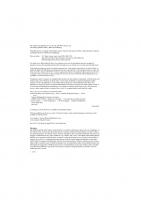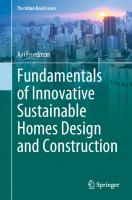Design and Optimization of Innovative Food Processing Techniques Assisted by Ultrasound: Developing Healthier and Sustainable Food Products 9780128182758, 012818275X
Design and Optimization of Innovative Food Processing Techniques Assisted by Ultrasound: Developing Healthier and Sustai
293 52 14MB
English Pages 370 [357] Year 2020
Table of contents :
Front-Mat_2021_Design-and-Optimization-of-Innovative-Food-Processing-Techniq
Front matter
Copyrig_2021_Design-and-Optimization-of-Innovative-Food-Processing-Technique
Copyright
Contribut_2021_Design-and-Optimization-of-Innovative-Food-Processing-Techniq
Contributors
Prefac_2021_Design-and-Optimization-of-Innovative-Food-Processing-Techniques
Preface
1---Mind-the-gap-in-the-knowledge-of-the_2021_Design-and-Optimization-of-Inn
Mind the gap in the knowledge of the potential food applications of ultrasound based on its mechanism of action
Introduction
Principle and mechanism of action of ultrasound
High-power ultrasound in food technology
HPU applications
Extraction
Preservation
Improvement of food properties
Emulsification
Crystallization
Filtration and drying
Low-power ultrasound in food technology
Advantages and limitations of ultrasound
Conclusions
Acknowledgments
References
2---Modeling-approaches-to-optimize-th_2021_Design-and-Optimization-of-Innov
Modeling approaches to optimize the recovery of polyphenols using ultrasound-assisted extraction
Introduction
Ultrasound-assisted extraction
Factors influencing UAE
Frequency
Intensity
Solvent
Temperature
Matrix particles
Shape and size of ultrasonic devices
Ultrasonic apparatus
Ultrasonic bath
Ultrasonic probe
Optimization and modeling of UAE of phenolic compounds
Response surface methodology
Current machine learning models
Mathematical models based on Fick's law or some type of rate law
Computational fluid dynamics
Thermodynamics studies
Final remarks
Acknowledgments
References
3---Ultrasound-as-a-pre_2021_Design-and-Optimization-of-Innovative-Food-Proc
Ultrasound as a preservation technique
Introduction
Fruit and vegetables
Milk and derived products
Meat and fish
Conclusions and future perspectives
Acknowledgments
References
4---Ultrasound-to-improve-drying-pro_2021_Design-and-Optimization-of-Innovat
Ultrasound to improve drying processes and prevent thermolabile nutrients degradation
Introduction
The characteristics of the drying process
The utilization of ultrasound in the drying process
The improvement of the drying process by ultrasound
Designing of the quality of food by the means of ultrasound enhanced drying
Conclusions
Acknowledgments
References
5---Application-of-ultrasound-to_2021_Design-and-Optimization-of-Innovative-
Application of ultrasound to obtain food additives and nutraceuticals
Introduction
Principles of UAE
Instrumentation
Factors affecting UAE efficiency
Effect of ultrasound operating parameters
Effects of matrix
Solvent type and liquid-to-solid ratio (L/S)
Temperature
Extraction time
Advantages and disadvantages of UAE
Application of UAE to obtain food additives and nutraceuticals
Polyphenols
Colorants
Carotenoids
Anthocyanins
Betalains
Lipids
Stabilizers
Proteins
Conclusions
References
6---Application-of-high-intensity-ult_2021_Design-and-Optimization-of-Innova
Application of high-intensity ultrasound in food processing for improvement of food quality
Introduction
Drying
Extraction
Freezing
Fermentation
Crystallization
Emulsification/homogenization
Foaming
References
7---Ultrasound-to-obtain-a_2021_Design-and-Optimization-of-Innovative-Food-P
Ultrasound to obtain aromatized vegetable oils
Ultrasound techniques at the laboratory and industrial scale
Vegetable oils: Major and minor components
Major components
Minor components
Mono- and diglycerides
Phospholipids
Free fatty acids
Sterols
Tocopherols and tocotrienols
Water
Pigments
Other minor compounds
Ultrasound extraction of bioactive molecules using vegetable oils as solvents
Mechanism of ultrasonic extraction
Future trends
References
8---Ultrasound-for-bev_2021_Design-and-Optimization-of-Innovative-Food-Proce
Ultrasound for beverage processing
Introduction
Energy-based types of ultrasound
Low-energy ultrasound
Principles of low-energy ultrasounds
High-energy ultrasound
Principles of high-energy ultrasound
Fundamentals
Generation of ultrasound
Process parameters
Types of sonication
Ultrasound applications in food science and technology
Benefits of ultrasonication
Ultrasound in processing of milk and dairy products
Ultrasound in processing of fermented beverages
Application of ultrasound in water treatment
Ultrasound in processing of fruit juices
Ultrasound application in carbonated beverages
Conclusion and future perspectives
References
9---Improvement-of-freezing-p_2021_Design-and-Optimization-of-Innovative-Foo
Improvement of freezing processes assisted by ultrasound
Introduction
Freezing of food
Physical properties of frozen food and water
Time of particular freezing stages-Plancks theory
Crystallization and glass transitions affected by the structure and food composition
Recrystallization
The mechanism of the impact of ultrasound on the freezing process
The improvement of freezing process by ultrasound-Experimental results
The impact of US-assisted freezing on the quality of food
Conclusions
Acknowledgments
References
10---Development-of-fermented-f_2021_Design-and-Optimization-of-Innovative-F
Development of fermented food products assisted by ultrasound
Introduction
Ultrasounds as a pre-treatment for fermentation processes
Dairy products
Other products
Fermentation processes assisted by ultrasounds
Dairy products
Alcoholic beverages
Monitorization of fermentative processes
Ultrasounds as a post-treatment of fermented food products
Dairy products
Alcoholic beverages
Conclusions and future perspectives
Acknowledgments
References
11---Sonocrystal_2021_Design-and-Optimization-of-Innovative-Food-Processing-
Sonocrystallization
Introduction
Fundaments of crystallization and the role of US
Role of sonocrystallization in sustainable food production
Sonocrystallization of fat, oils, oil-based products
Sonocrystallization of amino acids
Sonocrystallization of lactose
Development of healthier foods with sonocrystallization
Elaboration of lipid-based ingredients with sonocrystallization technology
Reducing the sodium chloride content in food products
Conclusion and further considerations
Acknowledgments
References
12---Application-of-hydrodynam_2021_Design-and-Optimization-of-Innovative-Fo
Application of hydrodynamic cavitation in food processing
Introduction
Basics of hydrodynamic cavitation
Different configurations of hydrodynamic cavitation reactor
High-pressure homogenizer
High-speed homogenizer
Low-pressure hydrodynamic cavitation devices
Other rotational HC reactors
Hydrodynamic jet mixer
HC+AC reactor
Guidelines for selection of operating conditions and reactor configurations
Applications of hydrodynamic cavitation in food industry
Microbial inactivation
Extraction
Nanoemulsions
Viscosity reduction
Beer production and gluten-free beer
Rehydration
Formulation of Greek styled yogurts
Improved antioxidant activity
Comparison of hydrodynamic and ultrasonic cavitation: Some specific case studies
Oil in water emulsion
Case study for effect of HC processing on physicochemical properties and microbial inactivation of peanut milk
Effect on soy protein isolate functionality
Degumming of crude soybean oil
Energy and techno-economical assessment
Conclusions and future aspects
References
Inde_2021_Design-and-Optimization-of-Innovative-Food-Processing-Techniques-A
Index
Front-Mat_2021_Design-and-Optimization-of-Innovative-Food-Processing-Techniq
Front matter
Copyrig_2021_Design-and-Optimization-of-Innovative-Food-Processing-Technique
Copyright
Contribut_2021_Design-and-Optimization-of-Innovative-Food-Processing-Techniq
Contributors
Prefac_2021_Design-and-Optimization-of-Innovative-Food-Processing-Techniques
Preface
1---Mind-the-gap-in-the-knowledge-of-the_2021_Design-and-Optimization-of-Inn
Mind the gap in the knowledge of the potential food applications of ultrasound based on its mechanism of action
Introduction
Principle and mechanism of action of ultrasound
High-power ultrasound in food technology
HPU applications
Extraction
Preservation
Improvement of food properties
Emulsification
Crystallization
Filtration and drying
Low-power ultrasound in food technology
Advantages and limitations of ultrasound
Conclusions
Acknowledgments
References
2---Modeling-approaches-to-optimize-th_2021_Design-and-Optimization-of-Innov
Modeling approaches to optimize the recovery of polyphenols using ultrasound-assisted extraction
Introduction
Ultrasound-assisted extraction
Factors influencing UAE
Frequency
Intensity
Solvent
Temperature
Matrix particles
Shape and size of ultrasonic devices
Ultrasonic apparatus
Ultrasonic bath
Ultrasonic probe
Optimization and modeling of UAE of phenolic compounds
Response surface methodology
Current machine learning models
Mathematical models based on Fick's law or some type of rate law
Computational fluid dynamics
Thermodynamics studies
Final remarks
Acknowledgments
References
3---Ultrasound-as-a-pre_2021_Design-and-Optimization-of-Innovative-Food-Proc
Ultrasound as a preservation technique
Introduction
Fruit and vegetables
Milk and derived products
Meat and fish
Conclusions and future perspectives
Acknowledgments
References
4---Ultrasound-to-improve-drying-pro_2021_Design-and-Optimization-of-Innovat
Ultrasound to improve drying processes and prevent thermolabile nutrients degradation
Introduction
The characteristics of the drying process
The utilization of ultrasound in the drying process
The improvement of the drying process by ultrasound
Designing of the quality of food by the means of ultrasound enhanced drying
Conclusions
Acknowledgments
References
5---Application-of-ultrasound-to_2021_Design-and-Optimization-of-Innovative-
Application of ultrasound to obtain food additives and nutraceuticals
Introduction
Principles of UAE
Instrumentation
Factors affecting UAE efficiency
Effect of ultrasound operating parameters
Effects of matrix
Solvent type and liquid-to-solid ratio (L/S)
Temperature
Extraction time
Advantages and disadvantages of UAE
Application of UAE to obtain food additives and nutraceuticals
Polyphenols
Colorants
Carotenoids
Anthocyanins
Betalains
Lipids
Stabilizers
Proteins
Conclusions
References
6---Application-of-high-intensity-ult_2021_Design-and-Optimization-of-Innova
Application of high-intensity ultrasound in food processing for improvement of food quality
Introduction
Drying
Extraction
Freezing
Fermentation
Crystallization
Emulsification/homogenization
Foaming
References
7---Ultrasound-to-obtain-a_2021_Design-and-Optimization-of-Innovative-Food-P
Ultrasound to obtain aromatized vegetable oils
Ultrasound techniques at the laboratory and industrial scale
Vegetable oils: Major and minor components
Major components
Minor components
Mono- and diglycerides
Phospholipids
Free fatty acids
Sterols
Tocopherols and tocotrienols
Water
Pigments
Other minor compounds
Ultrasound extraction of bioactive molecules using vegetable oils as solvents
Mechanism of ultrasonic extraction
Future trends
References
8---Ultrasound-for-bev_2021_Design-and-Optimization-of-Innovative-Food-Proce
Ultrasound for beverage processing
Introduction
Energy-based types of ultrasound
Low-energy ultrasound
Principles of low-energy ultrasounds
High-energy ultrasound
Principles of high-energy ultrasound
Fundamentals
Generation of ultrasound
Process parameters
Types of sonication
Ultrasound applications in food science and technology
Benefits of ultrasonication
Ultrasound in processing of milk and dairy products
Ultrasound in processing of fermented beverages
Application of ultrasound in water treatment
Ultrasound in processing of fruit juices
Ultrasound application in carbonated beverages
Conclusion and future perspectives
References
9---Improvement-of-freezing-p_2021_Design-and-Optimization-of-Innovative-Foo
Improvement of freezing processes assisted by ultrasound
Introduction
Freezing of food
Physical properties of frozen food and water
Time of particular freezing stages-Plancks theory
Crystallization and glass transitions affected by the structure and food composition
Recrystallization
The mechanism of the impact of ultrasound on the freezing process
The improvement of freezing process by ultrasound-Experimental results
The impact of US-assisted freezing on the quality of food
Conclusions
Acknowledgments
References
10---Development-of-fermented-f_2021_Design-and-Optimization-of-Innovative-F
Development of fermented food products assisted by ultrasound
Introduction
Ultrasounds as a pre-treatment for fermentation processes
Dairy products
Other products
Fermentation processes assisted by ultrasounds
Dairy products
Alcoholic beverages
Monitorization of fermentative processes
Ultrasounds as a post-treatment of fermented food products
Dairy products
Alcoholic beverages
Conclusions and future perspectives
Acknowledgments
References
11---Sonocrystal_2021_Design-and-Optimization-of-Innovative-Food-Processing-
Sonocrystallization
Introduction
Fundaments of crystallization and the role of US
Role of sonocrystallization in sustainable food production
Sonocrystallization of fat, oils, oil-based products
Sonocrystallization of amino acids
Sonocrystallization of lactose
Development of healthier foods with sonocrystallization
Elaboration of lipid-based ingredients with sonocrystallization technology
Reducing the sodium chloride content in food products
Conclusion and further considerations
Acknowledgments
References
12---Application-of-hydrodynam_2021_Design-and-Optimization-of-Innovative-Fo
Application of hydrodynamic cavitation in food processing
Introduction
Basics of hydrodynamic cavitation
Different configurations of hydrodynamic cavitation reactor
High-pressure homogenizer
High-speed homogenizer
Low-pressure hydrodynamic cavitation devices
Other rotational HC reactors
Hydrodynamic jet mixer
HC+AC reactor
Guidelines for selection of operating conditions and reactor configurations
Applications of hydrodynamic cavitation in food industry
Microbial inactivation
Extraction
Nanoemulsions
Viscosity reduction
Beer production and gluten-free beer
Rehydration
Formulation of Greek styled yogurts
Improved antioxidant activity
Comparison of hydrodynamic and ultrasonic cavitation: Some specific case studies
Oil in water emulsion
Case study for effect of HC processing on physicochemical properties and microbial inactivation of peanut milk
Effect on soy protein isolate functionality
Degumming of crude soybean oil
Energy and techno-economical assessment
Conclusions and future aspects
References
Inde_2021_Design-and-Optimization-of-Innovative-Food-Processing-Techniques-A
Index

- Author / Uploaded
- Francisco J. Barba
- Giancarlo Cravotto
- Farid Chemat
- José Manuel Lorenzo Rodriguez
- Paulo Eduardo Sichetti Munekata
- Similar Topics
- Technique
- Food Manufacturing
![Functional Food Products and Sustainable Health [1st ed.]
9789811547157, 9789811547164](https://ebin.pub/img/200x200/functional-food-products-and-sustainable-health-1st-ed-9789811547157-9789811547164.jpg)

![Food biochemistry and food processing [2 ed.]
081380874X, 9780813808741](https://ebin.pub/img/200x200/food-biochemistry-and-food-processing-2nbsped-081380874x-9780813808741.jpg)

![Rice By-products: Phytochemicals and Food Products Application [1st ed.]
9783030461522, 9783030461539](https://ebin.pub/img/200x200/rice-by-products-phytochemicals-and-food-products-application-1st-ed-9783030461522-9783030461539.jpg)




